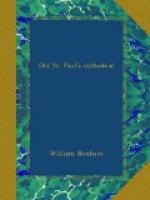[Illustration: SEALS OF THE DEAN AND CHAPTER. From Casts in the Library of St. Paul’s Cathedral.]
[Illustration: ORGAN AND TRUMPETS. From a Collection of Miniatures from Choral Service Books. Fourteenth Century. British Museum, 29902.]
Bishop Richard of Gravesend (d. at Fulham, 1306) made his will at his Manor House of Haringay, in 1302. It is written with his own hand, and the opening words are: “Imprimis, Tibi, o pie Redemptor, et potens Salvator animarum, Domine Jesu Christe, animam meam commendo; Tibi etiam, o summe Sacerdos et vere Pontifex animarum, commendo universam plebem Londonensis civitatis et diocaesis; obsecrans te, per medicinam vulnerum tuorum, qui in cruce pependisti, ut mihi et ipsis, concessa perfecta venia peccatorum, concedas nos ad tuam misericordiam pervenire, et frui beatitudine, tuis electis perenniter repromissa.” After which he goes on to direct that he shall be buried close to his predecessor, Henry de Sandwiche, whom he calls his special benefactor, and that the marble covering his grave shall not rise higher than the pavement; that out of his personal estate, consisting of books, household goods, corn and cattle, which together is valued at 2000 marks, 140_l_. shall be given to the poor, 100 marks to the new fabric of the cathedral, and that lands of the value of 10_l_. a year shall be bought for the founding of a chantry here for his soul, and for the keeping of his anniversary.
In the Inventory of his goods we have interesting information about values: wheat is reckoned at 4_s_. the quarter, peas at 2_s_. 6_d._, and oats at 2_s._ Bulls are worth 7_s._ 4_d._ each, kine 6_s._, fat muttons 1_s._, ewes 8_d._, capons 2_d._, cocks and hens 1_d._ His nephew, Stephen, who succeeded him thirteen years later, allows only 100 marks for the expenses of his funeral, quoting St. Augustine that funeral parade may be a certain comfort to the living, but is of no advantage to the dead. He disposes of 140_l._ to the poor tenants on his manors. Bishop Michael Northburgh (d. 1362) left the rents of certain houses which he had built at Fulham for a chantry priest, who was to be appointed by the Bishop of London. He also desired to be buried on the same day he died, with his face exposed to view, outside the west door of the cathedral. His endowment of the chantry being judged to be insufficient, one of the nominated chantry priests gave a further endowment for it. This Bishop Northburgh left 2000_l._ for the completion of the house of the Carthusians (Charter House) in co-operation with Sir Walter Manny. He also left 1000 marks to be put into a chest in the Cathedral Treasury, out of which any poor layman might, for a sufficient pledge, borrow 10_l._, the Dean and principal Canons 20_l._ upon the like pledge; the Bishop 40_l._; other noblemen or citizens 20_l._ for the term of a year. If at the year’s end the money was not repaid, the preacher at Paul’s Cross was to notify the fact, and to announce that the pledge would be sold within fourteen days if it were not redeemed, and any surplus from the sale would be handed to the borrower, or his executors. If there were no executors then the money was to go back to the chest, and be spent for the health of his soul. There were three keys to the chest, one was kept by the Dean, another by the oldest Canon-resident, and the third by a Warden appointed by the Chapter.




